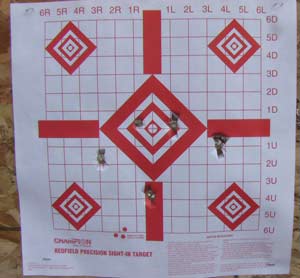SHOOTING THE HAWKEN RIFLE
Given the conditions I was surprised to see I had the range all to my self. Actually you should make every effort to test your equipment under adverse conditions because, at least in Montana, hunting season and inclement weather go hand in hand. Rifle/load combinations from a bench at 70 degrees will behave differently from an improvised rest near zero temperatures. Muzzle velocities can vary as much as 150 fps, point of impact may shift several inches. Additionally, cold numb fingers exhibit less trigger control, cheek weld is inconsistent, breathing not so regulated…the list goes on.
The original Hawken rifle from the renowned gun makers Sam and Jake Hawken of Saint Louis Missouri, produced from the early 1820’s through the 1850’s, carried by legendary mountain men such as Kit Carson, Jim Bridger and who could forget Robert Redford’s memorable performance in The 1972 film classic Jeremiah Johnson?

The test rifle is a custom reproduction from the 1970's. It has a 32 inch barrel, 1 – 48 inch twist, deep cut rifling, buck horn rear sight and blade front. As with any firearm, before you handle or shot, read all the manufacture’s included literature, know the nomenclature, safe handing and operational characteristics. While on the range or in the field now your intended target and what is behind it. Be safe.
I knew the rifle was up to task, I’d perfected accurate plinking and hunting loads. My plinking load consists of 60 grains of Goex 2F, a Hornady .530 round ball (230 grains), a .010 Eastern Maine lubricated patch and a CCI #11 cap. This load is very pleasant and with a sight picture placing the top of the front blade in the top of the buck horn notch and holding on the intended point of impact at 50 yards shoots 2 – 4 inch five shot groups. After you have a good load worked up, mark your ramrod even with the muzzle after tamping the load. This will ensure you maintain a consistent powder compression.
A good accurate hunting load is more challenging to develop. A hunting load is a balance between velocity, which translates to foot pounds of impact energy, and accuracy. I want at least 750 foot pounds of impact energy and will only shoot a distance I know I can hit a vital zone. For me its 75 yards, 50 would be better.
I worked my plinking load up in increments of 10 grains and at 120 grains the group size opened up to over 6 inches at 50 yards. One hundred and ten grains of 2F measured just over 5 inches, 1850 fps and 1900 foot pounds of muzzle energy. Given the ballistic co-efficient of .075, a .530 round ball sheds energy very rapidly but is good to 75 yards. Once again, mark you ramrod.

Today I would test this load from a standing rest using a 6 x 6 cover support and shot at 50 yards. I fired 5 shots at a fairly rapid pace, no cleaning. As you can see the group is very different from once fired on a nice day, 7 inches wide, 4 inches high. I’m satisfied I could duplicate this effort in the field.
I tend to limit the gear I carry on a hunt, I use a pistol flask with a tethered measure, because I can operate it with gloves on, I carry a Ted Cash capper, again ease of operation, and a small bag with patches and balls. I do carry two tools: a nipple wrench and a screw to pull a ball in the event I have a miss fire I can’t ignite.
Hunting with a muzzle loading rifle provides a feel for how the mountain lived. A very rewarding experience. Give it a try, you may find the center-fire collecting dust next hunting season.
Have Fun, Be Safe, & see you next month.
Warren K. Mayes
Technical Advisor, The Possible Shop